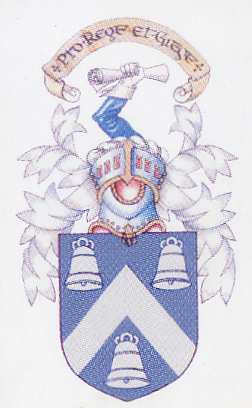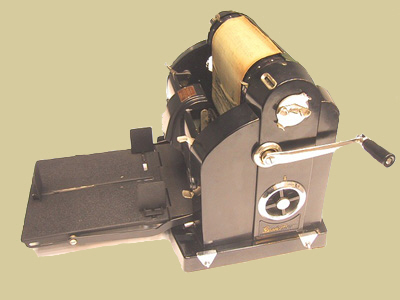
The Madras College Archive

|
|
The Madras College Archive |
 |
|
The Abbey Times remembered |

|
I first met Dr
Thompson on a rainy day in Edinburgh towards the end of my training at
Moray house. We talked about everything under the sun except my
application for a job at Madras. Every time I tried to steer the
conversation in that direction he would deftly change the subject. As we
parted, he said, “Nice meeting you. I’ll see you in September then,” and
strode off[1]. |
|||
|
J. D. had taught at the
old Burgh School in Abbey Walk, and one of his initiatives in his new
establishment was the institution of the Abbey Times[3].
This was a weekly news sheet, normally consisting of two A4 sheets printed
front and back, and then stapled together. It was produced on an old
turn-the-handle Gestetner duplicator which resided permanently in room 206
where all of his classes took an active role in the production process.
Every week, teams of reporters would scour the school searching out news.
Any stray pupils found wandering the corridors would usually justify
themselves by claiming that they were “doing the Abbey Times.” |
 |
||
| Notice boards would be carefully inspected,
and their content duly copied down. The P. E. department would be visited,
and the results of matches and dates of sporting fixtures were collected.
Anything at all that might be considered newsworthy was assembled. In the
library there was the ‘Abbey Times Box’ in which pupils could post letters
for publication in the next issue, or make proposals for features. Apart
from the letters there were usually some sweetie papers, and the
occasional unprintable suggestion. Anonymous postings were automatically
disqualified. |
|||
|
|||
| The format in these days was not very
elaborate. There was a supply of page one header sheets with the Abbey
Times logo that had been made in advance using a special stencil, and
stockpiled. Typing on the page one stencil had to be adjusted to take this
format into account. Columns and headlines could be done using plastic
stencils and a special tool designed for the purpose, though this took
some skill, as the stencil was prone to tearing. A small team operated the Gestetner. There was one pupil to turn the handle. This was a skilled job. If the handle was turned too quickly the stencil could tear, which was a disaster as it meant that another one had to be typed out. Too slowly and the print could smudge. Another pupil kept an eye on the print quality and stood ready to press the button that fed extra ink into the roller. Another was on the alert for paper jams and checking that the machine hadn’t sent through blank sheets. When page one was printed, the page two stencil was put on the machine, and the process began again. Woe betide the production team that inserted the paper the wrong way into the feeder tray so that page two emerged upside down. Eventually there were two neat piles of printed pages ready for the stapling teams to spring into action. The completed copies were made up into bundles of ten. This took place on ‘Abbey Times Day’. This was determined each session by the necessity for J. D. to have a double period at the end of the day, during which time the class in question could go through the final stages of production and distribution. Teams of pupils were mobilised to go around the school, visiting each class and selling the latest edition. Each team had a clipboard on which was entered the number of copies they started out with and a tally of the number of copies sold, and this could be reconciled with the amount of money taken. The staff room and the offices were not missed out. Even the sick room was checked. Each copy cost 1p and sales were good – almost everybody bought one. The money was put aside to purchase stocks of paper, staples and tubes of black ink. Any surplus was put in a savings account at the Trustee Savings Bank in Church Street. J. D. became an Assistant Rector[4], and in recognition of his new duties his teaching load was substantially reduced. This meant that he could no longer be responsible for the Abbey Times. His successor, Mr Gourlay, was disinclined to take on the work, and soon moved on, so it fell to my lot to take over. When I became Depute Principal, I was keen for the Abbey Times to keep going, but I was concerned that the J. D. way of doing things interfered too much with class teaching. He argued that it taught a variety of valuable skills, which is true enough in a way, but there was still a curriculum to get through. The solution was a small but highly motivated Abbey Times team of pupil volunteers, who met with me at lunchtimes and did the work of collecting the raw data[5]. I took over the job of correcting copy and typing. I managed to acquire a duplicator with an electric motor, which made things much easier. The team members soon became adept at using it. The publication retained its old format, and its tone was much the same, but as time went by there were technical innovations. The first of these was the acquisition of a surplus electric typewriter, which made the production of stencils much easier. The auxiliary office had a scanner that could produce a Gestetner-ready stencil from copy that incorporated photographs. The quality was not wonderful, but it was a distinct improvement. The advent of the BBC computer, with its dot-matrix printer, seemed to signal the ultimate in technological wizardry. Its Edword programme[6] offered a choice of fonts, a choice of font size, the options of bold, italic and underline, the ability to cut and paste, and to justify text. It seemed amazing at the time, but then came the Apple Mac, and programmes like Adobe Pagemaker. This enabled Madras College to produce camera-ready copy of its first Prospectus in-house, though I remember that at the time Mr Pardoe and I were the only people in the school who knew how to navigate Pagemaker. The advent of Bob Edgar as Principal Teacher brought about some long-overdue changes. He determined that the days of staff being based solely in one building had to come to an end. Unlike J. D., who had exercised autocratic control in Kilrymont, I became Bob’s Depute in reality rather than just in name, and immediately found myself actively involved in the administration of the whole department – mostly in Kilrymont, it is true, but with teaching responsibilities in both buildings. When Standard Grade[7] came in, I was made responsible for its phased implementation. We planned timetables together, and collaborated on requisitions. All of this was welcome and necessary but it meant that I had to move around quite a lot, so I had less time at my disposal to meet up with my team. Then Bob became an Assistant Rector and I became Principal Teacher in his place and that was that. There was simply no time to prepare a weekly newspaper, because I had far too much to do. Besides, my stalwart team had moved on, and there were no obvious candidates to carry on their work. The combination of Pagemaker and the new generation of photocopiers was making the production of documents much quicker and easier, but the concept of the Abbey Times had probably had its day. Even its name was an anachronism, for nobody knew what it referred to. So Tennyson was right – The old order changeth. Was it worth doing? Yes. As an archive the old copies are valuable. Many pupils benefited from taking part. There were several of them who were not particularly academic, but still felt a great sense of pride and achievement when they held a copy of the Abbey Times that they had helped to produce. J. D. was right – it did introduce pupils to useful skills that they might not otherwise have acquired, not least the awareness of how much hard work goes into the production of a couple of pages that could be read in a few minutes. In the days before the Madras College Daily Sheet was instituted it was a valuable way of disseminating information throughout the school. The letter column did provide a forum for pupil opinion. Non, je ne regrette rien. Andrew Lindsay February 2011 |
|||
